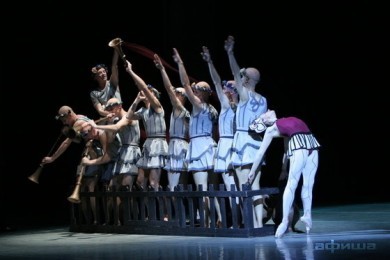Apollo
CREDITS
Music by Igor Stravinsky
Choreography by George Balanchine (1928)
Libretto by Igor Stravinsky
Staging by Francia Russell
Original lighting design by Ronald Bates
Lighting: Vladimir Lukasevich
World premiere: 12 June 1928, Les Ballets Russes de Serge de Diaghilev, Thйвtre Sarah Bernhart, Paris
Premiere at the Mariinsky Theatre: 26 January 1992
Premiere of last revived version at the Mariinsky Theatre: 30 April 1998
Running time 35 minutes
Apollo, the son of Zeus and Leto, achieves stunning levels of brilliance in dance and citherplaying. He is followed in his sequence of dance by his ever-present companions the three muses – Calliope (the muse of epic poetry), Polyhymnia (the muse of sacred hymns) and Terpsichore (the muse of dance). When Apollo, accompanied by his muses, appears on Mount Olympus everything around him falls silent in adoration of his divine art.
“I regard Apollo as a turning point in my life. In terms of discipline, restraint, the perpetual unison of sound and mood this score was a revelation for me. It seemed to be telling me that I didn’t have to use it all, that I could leave something out. In Apollo and all of the composer’s subsequent music it is impossible to imagine any one given extract to be an extract from another score. Each of them is unique, nothing can be replaced. I examined my own work in the light of that lesson.
It was when studying Apollo that I first understood that the gestures, like tones in music and shades in painting, find certain ‘native ties’ between themselves. Like any group they are subject to their own special laws. And the more solid the artist the more clearly he will understand and consider these laws. Starting with Apollo I developed my choreography along these lines, dictated by these mutual ties.
“Apollo has sometimes been criticised for its ‘lack of theatricality.’ It may be true that there is no vividly expressed story there (although there is a plotline that runs throughout). But its technique is that of classical ballet which in every sense is theatrical, and it is here that we see the start of the literal transformation of sound into visual movement.”
George Balanchine. The Dance Element in Stravinsky’s Music
Prodigal Son
CREDITS
Music by Sergei Prokofiev
Choreography by George Balanchine (1929)
Libretto by Boris Kochno (after the biblical parable)
Scenery and costumes: Georges Rouault
Scenery executed by Prince A. Schervashidze
Costumes executed by Vera Soudeikina
Staging: Karin von Aroldingen and Paul Boos
Original lighting design: Ronald Bates
Lighting: Vladimir Lukasevich
Premiere: 21 May 1929, Les Ballets Russes de Serge de Diaghilev, Thйвtre Sarah-Bernhardt, Paris
Premiere at the Mariinsky Theatre: 14 December 2001
Running time: 40 minutes
Prodigal Son was the last work Balanchine made for Diaghilev’s Ballets russes in 1929 with Serge Lifar in the role of the Prodigal Son; it was revived in 1950 by the New York City Ballet with Jerome Robbins in the title role. Its music by Prokofiev was written for the ballet, and its costumes and dйcor were created by Rouault, making it a perfect example of the collaborative efforts among artists that produced some of the best works of the Diaghilev era. New for a Diaghilev ballet was the Biblical theme and the religious spirit. In seeking eternal themes and turning to past artistic devices, western artists were trying to avoid the complete intellectual and artistic degeneration towards which their rootless experimentation was leading. Prodigal Son anticipated the trend toward religion of the 1930s and 40s. It was Diaghilev’s fate that he would always be ahead of fashion, even when he believed he had turned his back on vogue. The return of Prodigal Son to St Petersburg is of great significance. For the first time, a ballet of the most radical, late period of Diaghilev’s Saisons russes has returned to the stage of the Mariinsky Theatre. That period of Russian and world ballet has come home, which until recently was under artistic (avant-garde aesthetics of the late Diaghilev era) and ideological (use of religious motifs) censorship.
With the return of Prodigal Son, the Mariinsky Theatre and its generation of young dancers have begun to restore an objective picture of the development of ballet in the 20th century.
The Firebird
Music by Igor Stravinsky
Libretto by Michel Fokine
Choreography by Michel Fokine (1910)
Reconstruction: Isabelle Fokine, Andris Liepa
Set and costume design: Anna and Anatoly Nezhny
after original sketches: Alexander Golovin, Lйon Bakst and Michel Fokine
Lighting Designer: Vladimir Lukasevich
World premiere: 25 June 1910, Les Ballets Russes de Serge de Diaghilev, Thйвtre de lґOpйra, Paris
Premiere at the Mariinsky Theatre: 26 May 1994
Running time: 50 minutes
 Mariinsky Theatre:
Mariinsky Theatre:  Mariinsky-2 (New Theatre):
Mariinsky-2 (New Theatre):  Mariinsky Concert Hall:
Mariinsky Concert Hall: 

